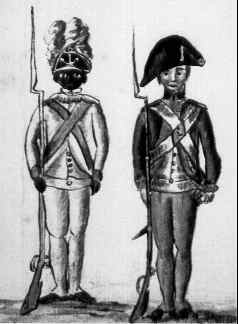Celebrating the Fourth of July: Black Military Service during the Revolutionary War
 Continental soldiers at Yorktown; an African-American soldier of the 1st Rhode Island Regiment (left).
Continental soldiers at Yorktown; an African-American soldier of the 1st Rhode Island Regiment (left).
Perhaps the most famous African American discussed in relation to the American Revolution is Crispus Attucks, who was also Natick Indian, the first casualty of the Boston Massacre in March 5, 1770. The incident occurred prior to the onset of fighting, however, the event was later propagandized and the tensions surrounding the incident and the resulting fallout were a catalyst for the beginning of the war. John Adams wrote that the “foundation of American independence was laid” on the massacre.
Once the war started in 1775 at Lexington and Concord, Blacks continued to play an important role. It has recently been estimated that around 9,000 blacks fought for the Patriot Army, as many believed the new nation would expand their civil rights. Additionally, many slaves enlisted because they could directly gain freedom. One example of that is Peter Salem: when his owner, Lawson Buckminster, became a Major in the Continental Army, he granted Salem his freedom so that he could enlist in the patriot militia. Salem fought in the Battles of Concord and Bunker Hill, serving in total almost five years. After the war, be married and became a cane weaver. Later on in the war, the Continental Army in New England directly recruited black slaves by offering them freedom in exchange for their service (and compensating their owners with money).
Looking at the Battle of Bunker Hill in particular, there were around three dozen blacks who fought there. One participant was Barzillai Lew, a freeman who had previously fought against the French and Indians in 1760. There is an anecdote that Lew’s rendition of “There’s Nothing Makes the British Run like Yankee Doodle Dandy” on the powder horn buoyed morale throughout the battle.
However, not all patriots were receptive to enlisting blacks. Slave owners feared they would no longer have labor and many other whites feared that armed blacks would rise up against them. George Washington was particularly resistant to this idea, ordering recruiters specifically not to recruit “negroes,” among others, in 1775. This policy eventually ended due to manpower shortages. Three years after the order, Rhode Island was not reaching its troop quotas, thus General Varnum asked Washington to lift the ban. Washington passed this on to the government of the state and the Assembly voted to allow “negro, mulatto, or Indian” slaves to enlist and compensate them with freedom. This successfully increased the 1st Rhode Island Regiment’s numbers.
At the same time, the British were also taking advantage of slaves to bolster their forces. Lord Dunmore, the royal governor of Virginia, issued a proclamation in November 7, 1775 saying that: “I do hereby further declare all indented servants, Negroes, or others, (appertaining to Rebels,) free, that are able and willing to bear arms, they joining His Majesty’s Troops.” By December, over 300 former slaves had enlisted and were designated as “Lord Dunmore’s Ethiopian Regiment.”
When the war ended, the situation for slaves who had served varied greatly. Some owners reneged on their promises of freedom, sending them back to servitude. For others, they became citizens of the new country: at the time of the Constitution’s ratification, free black men could vote in five of the thirteen states. For the many who were freed, most were pushed out of the military—an action that was formalized by the United States Congress in 1792 when service was restricted to white male citizens.
Although the departing Loyalists took thousands of slaves with them to other colonies in the West Indies, many slaves who had fought for the British were freed and resettled in Nova Scotia as well as London. Due to discrimination and the climate (in Nova Scotia), many eventually were relocated again to Freetown, Sierra Leone in 1792.
To learn more about Black participation in the Revolutionary War, you can read:
- Foner, Philip. Blacks in the American Revolution. Westport, Conn.: Greenwood Press, 1976
- Gilbert, Alan. Black Patriots and Loyalists: Fighting for Emancipation in the War for Independence (University of Chicago Press, 2012).
- Lanning, Michael. African Americans in the Revolutionary War. New York: Kensington Publishing, 2000.
- Nell, William C. The Colored Patriots of the American Revolution (1855).
- Quarles, Benjamin. The Negro in the American Revolution. Chapel Hill: University of North Carolina Press, 1961.
